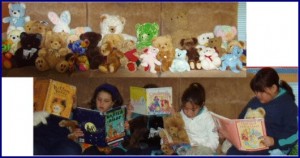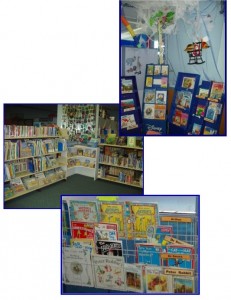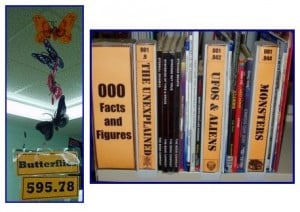
The mission statement for my library included this statement
We are dedicated to providing and promoting
intellectual and physical access for all
to an extensive range of print and electronic resources,
tools and technologies
It sounded very grand in theory but what did it look like in practice? Was it even put into practice? Or was it one of those statements that had no substance behind it?
Achieving this part of the mission statement became a very real necessity as the school grew and more and more students enrolled. While every child has their own specific special needs, some experience more challenges than others and as the student population grew so did the number of students with particular needs, both mainstream and in the Learning Support Unit which specialised in working with children of the autism spectrum.
One of these special children was Molly who was a delightful child, but who suffered from severe and very frequent epileptic episodes which intruded on her everyday functioning as well as her ability to learn. She was also the daughter of a close friend so when she entered Kindergarten at age 5, I vowed that she would be able to operate in the library as independently as she could and the spinoff would be that if she could so could all the other students.
It meant closely examining a number of things
- how the regular students used the library
- why they were there
- what they did when they were there
- how they used the space
- what they borrowed
- what they asked for or expected
- how they operated within it independently
- how Molly and the other special needs students used the library
- did their use of the library differ from that of mainstream students
- what were their expectations
- what were their frustrations
- how their expectations could be met and their frustrations overcome
- what their teachers expected of and needed from the library to support the students
- what we were already doing that was working
- what we needed to change to make it better
a familiar place
Above all there has to be an atmosphere that tells the special needs child they are welcome in the library and that they are children first and while their disability is addressed, their needs as a child are what drives what we do. Invite the children in with their aides (and parents if possible) when there are no other students in there so you can introduce yourself and any other adults who will assist them and show them around explaining how their needs can be met and seek suggestions for improvements. Talk to the adults about any particular needs a child has and not just how these can be met but how the child might contribute. For example, Lochie loved routine so he took on the responsibility of feeding the goldfish every morning. In consultation with his parents, his reward was to take them home at the end of each year (so they wouldn’t starve over vacation) and they bought him an aquarium so he could continue his job. Goldfish are cheap in comparison to the joy and sense of responsibility it gave him as well as acknowledging his need for rhythm and routine.
Two senior boys with anger management issues who spent more time off the playground than on relished the opportunity to be in charge of a canned food collection while a couple of artistic girls wanted to wrap all the presents that we collected for the children of Charleville when a crippling drought meant Santa probably wouldn’t get there that year.
Provide teddies or other soft toys which the children can cuddle during storytime, read to or tell their secrets to. If a child got restless and started to throw the teddy or whatever, I’d just ask “Can teddy enjoy the story?’ and it brought about calm again. I ended up having a collection of about 50 teddies sitting on the couches so any child could come in at any time and share a story with a teddy. Angry kids, sad kids, kids having playground issues – there was never a teddy (or child) left unloved.
physical access
The first thing that usually comes to mind when we think of children with special needs is how a child in a wheelchair is going to access the shelves and while we think of allowing sufficient width between the aisles (and some jurisdictions have compulsory regulations to ensure this) it also means leaving room to manoeuvre the wheelchair at the ends of the rows. Because ours was a large library much of the collection had been arranged in ‘rooms’ rather than rows so this wasn’t a huge problem. Wherever possible and practical and particularly for fiction, I placed books in wall-shelves, dumpbins and displays at eye level for little ones so location and selection was easier. Face-out displays allowed for familiar titles, characters and authors to be easily recognised.
However, there does need to be careful consideration given to the floor-covering particularly if it is carpet. When it was refurbished, a local shopping centre laid acres of new carpet that was almost impossible to push either a wheelchair or a wheelie-walker on thus denying access to many shops and services for those not physically independent.
Shelf height is also an issue particularly for those school libraries serving older students who are taller so some compromises may have to be made. In the primary school library things have to be at a lower level so little five-year-olds can access them but nevertheless there has to be a system in place to enable those who struggle and an environment created where they feel comfortable in asking for assistance. Also think about the height of your Returns box, the circ desk and any computers that a child with a disability might access. Talk to their primary carers about their needs and how these might be addressed. While the provision of step-stools may appeal, these themselves can provide even more problems.
I wish I had a dollar for every time I’ve asked children to tuck their chairs in as they rush off in their eagerness to be wherever they need to be and another dollar for every time the plea fell on deaf ears and I’ve had to go round and tuck them in myself. But chairs and bags and so forth can be significant hazards for those with mobility issues so the nagging has to continue. However, when you relate to it a particular student’s movement – “Tuck your chair in so —- can get through” – it is surprising how quickly the children see the purpose of your request and it becomes automatic. Often they will remind their friends or just move something anyway!
resources
Under the Collection Policy the collection should offer resources in a diversity of formats to meet the learning styles of its users generally but it is essential that you look beyond the general population and examine the needs of specific groups within it. Consider the needs of
- indigenous students
- English language learners
- those with learning disabilities
- those with physical disabilities, particular illnesses or allergies
- those from other cultures and countries
- the religious philosophy of the school, if any
- the LGBTI community
Strive to have resources that will allow the children to read about themselves so they feel they are included and acknowledged. Seek out services that supply or adapt resources to meet the needs of these students such as Vision Australia Information and Library Service or the Geoff Gallop Braille and Talking Book Library Ensure your signage is large, visible and readable and include a picture or other non-text cue where appropriate.
As well as signage, write clear step-by-step instructions for using the OPAC or borrowing procedures or logging into the computers, including non-texts cues where necessary. These can become a teaching exercise for the students, peer-tested and then published. Make them available as bookmarks too.
social
As well as catering for the physical and learning needs, be aware of each child’s social and emotional needs so these can be addressed during teaching times. Some like to work alone, others with a partner or group members; some can cope with being touched or close to other children while this can be an anathema to others; some like public praise, others shy from it. Consider concentration spans (often quotes as the child’s age plus three minutes for regular children) and structure the time so there is a time to listen and a time to respond.
Talk to the teachers and aides about particular behaviour management routines that the child knows and responds to so that there is consistency between classroom and library including any strategies to be used in an emergency.
online
If your school has an online presence strive to make is as user-friendly as possible by making the information easily accessible even to those without a lot of language skills. This is the Resource Centre’s entry page of a particular school’s website that was based on that philosophy. Embedded in the graphic were links to various parts of the Centre’s website and there were small graphic-based buttons that led to pages as well.
Working with children with special needs is as rewarding as it is challenging. But if we have their needs as a child at the forefront of our practice, anything we do to make the library a better place for them makes it a better place for the other children as well.





